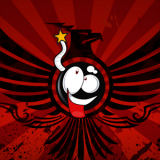My End Of 2019 Awards
By danielkempster 4 Comments
Hey there folks, and welcome to My End of 2019 Awards. As we reach the last days of the year, it becomes customary for everyone and their mother to put together a list of the best video games they’ve played in the last twelve months and put it up somewhere on the internet. While I can’t speak for my mother, I can at least confirm that I’ve played some games this year, and have seized this opportunity to write something about them and share it with all of you.
Compared to other years, 2019 was not an overly productive year for me in terms of playing video games. At the time of writing, I’ve recorded twenty-four games as beaten in the last twelve months, and I don’t expect that number to increase before the clock strikes midnight on December 31st. That’s nine games less than last year’s final total of thirty-three titles. That’s not the full story though. Of those twenty-four titles I’ve recorded, three of them represent cutscene movies which were watched rather than played, bringing the true total down to a mere twenty-one. Only 2016, with its paltry total of twelve titles beaten, ranks lower.
There hasn’t been a great deal of diversity in what I played either, at least not on the surface. A cursory glance through the list of games I’ve played this year reveals that almost half of the titles mentioned all come from the same franchise. A similar amount of the entries are games which I’ve played at least once before, a factor which usually negates a title’s eligibility for this kind of list. With all these limitations at play, I wasn’t sure I would be able to muster enough content to justify one of these year’s-end blogs. Thankfully, my worries have proven unfounded. If anything, I think my list for this year might be one of my most diverse and interesting yet.
As was the case last year, I won’t be acknowledging everything I’ve played this year by giving individual awards to each game. While I’ve enjoyed this approach in previous years, my game-playing habits have been so skewed towards one specific franchise this year that I wouldn’t feel comfortable revisiting that format. Instead, I’ll be restricting myself to a more conventional list of the ten games that best embody the time I’ve spent with a controller in my hands over the last twelve months.
It’s worth noting a couple of things before I start listing titles. First, this is not a ranked list. I’ve never been a fan of assigning a hierarchy to these lists, because the experiences offered by these games often differ so greatly that it becomes impossible to quantify one against another. I’ve listed the ten chosen games alphabetically, and none of the titles that I’ve selected should be assumed to hold more or less weight than any of the others. Second, this list is not restricted to games that have been released in this calendar year. It is intended to be a full reflection of the games I have played this year, and as someone who predominantly plays older video games, limiting myself only to 2019 releases would make it impossible to populate a full top ten list.
With all that said, let’s begin by moving to my first selection:
Celeste
(Matt Makes Games - Xbox One - 2018)
Celeste makes this list for a few reasons. First, it earns its spot by being a fantastic masocore indie platformer. This isn’t typically a genre that I enjoy playing. Indeed, Celeste is the first game of its kind since 2010’s Super Meat Boy that has not only piqued my interest, but managed to hold my attention right through to the end. Its controls are tight and responsive, its mechanics are simple to grasp, and its level design does a fantastic job of educating the player as it gradually ramps up the difficulty. All these factors conspire to make Celeste a game that rarely frustrated me, despite its often crushingly hard nature.
Celeste also holds the honour of being the last video game I intend to play on an Xbox console. Earlier this year I made the decision to step out of the Microsoft gaming ecosystem, in order to thin down my expansive video game collection before my girlfriend and I moved into a home of our own. Prior to making that decision, Celeste was the last video game I played on my Xbox One, having taken advantage of the Games with Gold programme to pick it up for free back in January. Celeste therefore serves as the final bookend for the eleven years I have spent playing games on Microsoft consoles, affording it a little extra reverence in my mind.
But if we’re being real, neither of these factors constitute the main reason for Celeste’s inclusion on this list. As someone who has suffered with low mood, depression and anxiety over the years, it was Celeste’s story, and the way it supports that story through its gameplay, that truly touched me in the relatively short amount of time I spent with it. Mental health issues can often make even the smallest of tasks feel like an insurmountable obstacle, a fact that makes Madeline’s allegorical ascent of Mt Celeste all the more relatable. What strikes me as truly special, though, is how Celeste’s moment-to-moment gameplay serves as a reminder that no mountain is ever climbed in an instant. In Celeste, each screen is a small, isolated ordeal that must be conquered before moving on to the next. If the player fails, there is no punishment for doing so. They are only set back to the start of the current screen and simply asked to try again. Celeste’s gameplay loop is centred around perseverance and tackling one thing at a time, teaching the player the important lesson that small steps add up to big progress. That’s a lesson I really needed this year, and I’m thankful to this game for teaching it to me.
Crash Team Racing: Nitro-Fueled
(Beenox - PlayStation 4 - 2019)
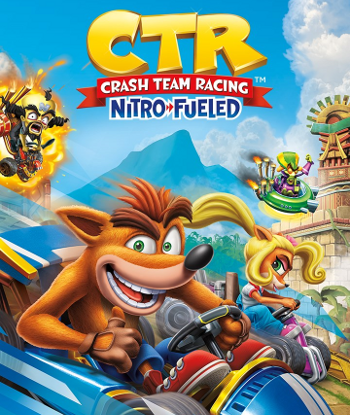
I’ve long held up Crash Team Racing as my favourite kart racer of all time. Its fantastic track design, feature-packed Adventure mode and peerless drift-boost system have always put it a cut above Mario Kart and its other imitators in my mind. When Activision announced their next retro-revival project was to be a ground-up remake of this underappreciated gem for the current generation, I was both ecstatic and terrified. The thought of an updated version of CTR with online multiplayer was an appealing one, but the original has such near-perfect “gamefeel” that I was worried developers Beenox wouldn’t be able to replicate it.
Thankfully, those worries were completely unfounded. Nitro-Fueled doesn’t just replicate CTR’s excellent gameplay and feature-set, it does what I previously thought impossible and improves upon them. The original’s fast and furious gameplay is intact, with some subtle tweaks to the drift-boost system that make it easier than ever before to navigate tracks at blistering top-speed. Alongside the entirety of CTR’s content, Nitro-Fueled boasts an expanded roster of tracks and racers by incorporating all of the characters and re-designed courses from its underwhelming PS2 follow-up Crash Nitro Kart, as well as offering a multitude of unlockable character skins, kart bodies, paint colours and wheel designs amounting to almost limitless customisation options. And as if that wasn’t enough, Beenox has continued to support the game post-launch with monthly Grand Prix events, each one bringing a handful of additional racers and karts along with a brand new track to learn and master. These Grands Prix have kept me coming back to the game over and over again since its launch six months ago, easily making CTR: Nitro-Fueled my most-played game of 2019.
Sadly it’s not all sugar and rainbows. The online multiplayer component of the package, one of its biggest draws, still feels woefully feature-light and continues to be plagued by connectivity issues even half a year after launch. Activision’s corporate greed has also managed to bleed into the game post-launch, retro-fitting microtransactions into the experience by allowing players to purchase Wumpa Coins (the in-game currency used to buy new characters, karts and skins from the Pit Stop storefront) with real-world money. It really hurts me to see such under-handed monetisation practices in what is ostensibly a game for children, and makes me reluctant to recommend it to newcomers. Even with these downsides, though, I can’t deny that Crash Team Racing: Nitro-Fueled is my new favourite kart racer of all time.
Kingdom Hearts
(Squaresoft - PlayStation 2 - 2002)
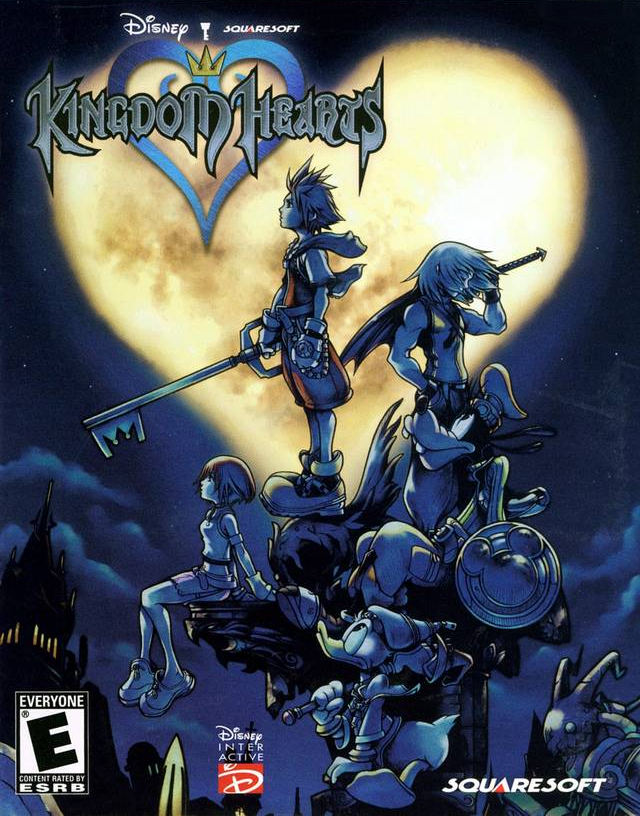
Placing the original Kingdom Hearts on this list feels like cheating. I usually enforce a rule that prohibits games I’ve already played before from qualifying for the top ten. In Kingdom Hearts’ case, I’ve already waived that rule once before when I replayed the remastered PlayStation 3 version back in 2015. To waive it a second time for another version of the same game feels unfair on many levels, but if you’re prepared to hear me out, hopefully you’ll agree with me that it has once again rightfully earned a place in the pantheon of games that defined my year.
2019 will go down in personal history as the year where I finally made it through the entire Kingdom Hearts franchise. It’s something I’ve been half-heartedly attempting to do since the first teaser trailer for Kingdom Hearts III dropped at E3 in 2013. I made a half-decent attempt back in 2015, making it about halfway through Kingdom Hearts II before burning out, stepping away and failing to return. A similar thing occurred last year where I foolishly committed myself to blogging my exploits alongside playing the games, a gargantuan endeavour that proved to be too much for me to manage as my enthusiasm for the playthrough and the accompanying Keyblade Chronicles series fizzled out very early on. Determined to make my third attempt successful, I set out a plan to clear a portion of the franchise each quarter – the contents of HD I.5 ReMIX between January and March, HD II.5 ReMIX between April and June, HD II.8 Final Chapter Prologue between July and September, and finally, Kingdom Hearts III between October and December.
The journey began, unsurprisingly, with the first Kingdom Hearts game – specifically the Final Mix version of the game included with the HD I.5 + II.5 ReMIX collection on PlayStation 4. I feel comfortable saying that this is the definitive way to play Kingdom Hearts in 2019. The upgrade to a buttery smooth sixty frames per second, alongside the previous quality-of-life improvements introduced in the PS3 release like right analog stick camera control and Kingdom Hearts II-style reaction commands mapped to the Triangle button, make this unarguably the best-feeling version of the game. The game itself remains an all-time favourite for me, melding real-time action and platforming with a pseudo-Final Fantasy menu-based combat system that rewards both careful strategising and quick reflexes in equal measure. It’s a little clunky in places, but if we’re being honest, there are very few games released in 2002 that aren’t. What have stood the test of time are its undeniable charm and its memorable cast of characters.
In April I found myself returning to Kingdom Hearts for my contribution to this year’s Giant Bomb Community Endurance Run. The twist in this particular tale was my attempt to play through the entire game in twenty-four hours, on the hardest difficulty, with my characters locked at Lv1. What ensued was one of the most unique video game experiences of my life. Without raw stats and a lengthy list of abilities to fall back on, I had to start really paying attention to the game’s choreography. I saw intricate patterns in boss fights that I’d previously only ever brute forced my way through, each major encounter becoming a deadly dance as I struggled to learn the steps on the fly before eventually mastering them and emerging victorious.
I didn’t complete the game unfortunately, coming unstuck at the Riku/Ansem fight in Hollow Bastion, but after twenty-four hours of play across two days I came away feeling like Neo at the end of The Matrix, like I could see the code flowing through everything. I’ve never attempted speedrunning, but I imagine that how I felt on that weekend in April is how speedrunners must feel when they run their chosen games. It was an experience that gave me a newfound appreciation of the mechanics of one of my all-time favourite video games. I’d really like to return to the main numbered entries in the Kingdom Hearts series at some point in the future and properly attempt Lv1 Proud/Critical runs of them. Just not any time soon – I’ve had enough Kingdom Hearts this year to last me a long time!
Kingdom Hearts II
(Square-Enix - PlayStation 2 - 2006)
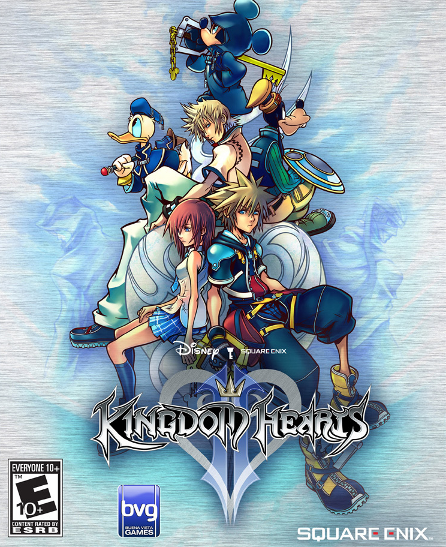
I feel less guilty about Kingdom Hearts II appearing on this list than I do about its predecessor. Although I have played the franchise’s second numbered entry before, I have only done so once, and it was around thirteen years ago when the game debuted on the PS2. Consequently, this is the first time that Kingdom Hearts II has been in the running for one of these lists, making me feel slightly more comfortable about its inclusion.
I’ve long been of the opinion that the first Kingdom Hearts is a better game than its sequel. I think that stance was born from being more familiar with the first game than the second, and thus more sentimentally attached to it. With the benefit of hindsight, and having played both games in a very short space of time, I feel comfortable saying that I’ve long held a very questionable opinion that I am now properly qualified to rethink. Kingdom Hearts II blows the first game completely out of the water in just about every way possible.
Kingdom Hearts II takes its predecessor’s gameplay as a proof of concept and refines it almost to the point of perfection. It scales back clumsy platforming and poor level design in favour of increased manoeuvrability in more open, less precarious environments. It replaces vague objectives with clear instructions and better signposting to steer the player in the right direction. And it augments the basic combat model with a dizzying number of options – basic Keyblade combos, equippable abilities (both active and passive), powerful magic spells, several specialised Drive Forms, Disney character Summons, collaborative Limits and opportunistic Reaction Commands. Every attack, spell, Form and ability has situational advantages and disadvantages, and many of them have both offensive and defensive properties, resulting in a deep combat system that encourages experimentation and rewards strategic play.
I even surprised myself by enjoying the story a lot more than I thought I would. It definitely marks the start of the franchise’s descent into full-on incomprehensible nonsense, and doesn’t touch the emotional resonance of the first game’s story in my humble opinion, but there’s no denying that the high points really hit me in the feels, especially with the added context provided by a wider knowledge of the series as a whole. Ultimately though, it’s the gameplay that wins out here. Kingdom Hearts II boasts one of the best combat systems ever seen in an action RPG, making it without a doubt one of the most fun video game experiences I had in 2019.
Kingdom Hearts III
(Square-Enix - PlayStation 4 - 2019)
If Kingdom Hearts earned its space on this list by being the game in the series that I have the fondest memories of, and Kingdom Hearts II earned its place by being the best-playing game in the series, then Kingdom Hearts III’s place is justified by it being the culmination of a journey over sixteen years in the making. This is the game that I’ve been waiting over a decade for, the one that I spent nine months of this year working towards, navigating the entire franchise from start to finish. In that respect, Kingdom Hearts III defines 2019 from a game player’s perspective for me better than anything else on this list.
Was it worth the wait? Kinda, I guess? It’s impossible to deny that the story is a badly-paced train-wreck of a narrative that meanders meaninglessly for thirty hours before trying frantically to tie up every loose end in its last three hours. From a plot perspective, it’s difficult to justify the number at the end of this game’s title, since it ties so heavily into subtitled side games like Birth by Sleep and Dream Drop Distance. It’s also difficult to get away from the fact that it feels both rushed and unfinished, a remarkable feat considering the game was in development for at least six years. The upcoming Re:Mind DLC looks set to address that by expanding the story and bringing a bevy of end-game content to bolster the base game. But I can only pass judgement on the game I’ve played as it currently stands, and right now it leaves more than a little to be desired.
From a gameplay perspective though, there is absolutely no denying that this is Kingdom Hearts III. After experimentation with Command Deck systems in the stop-gap titles, KHIII reverts to a command menu with an MP bar and a ton of options at the player’s disposal. Alongside the return of a spell menu, there are plenty of mechanics analogous to those of Kingdom Hearts II – Formchanges replace Drive Forms, Links and Attraction Flow replace Summons, and Limits and Reaction Commands are succeeded by context-sensitive Situation Commands. While Formchanges, Attraction Flow and Situation Commands are invariably powerful, the fact they are randomly triggered means it’s unreliable to build strategies around them. Consequently, I ended up eschewing them in favour of basic Keyblade combos and magic most of the time, resulting in combat that felt more limited than that of Kingdom Hearts II, despite offering a similar number of options. It’s still a lot of fun to play, but it often feels like substance has been sacrificed for style.
That being said, when it comes to picking my favourite games from the series, Kingdom Hearts III comfortably sits in the top three with its numbered brethren, flaws and all. As the game that encouraged me to play through an entire franchise in the space of nine months, just to see the conclusion of a story almost two decades in the making, it would be impossible to consider Kingdom Hearts III as anything other than one of the most important games I played in 2019.
Oddworld: Abe’s Oddysee – New ‘N’ Tasty!
(Oddworld Inhabitants - PlayStation 4 - 2014)
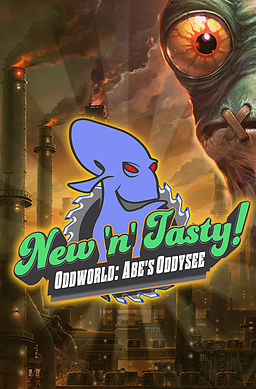
I may not talk about it much, but the Oddworld franchise has always been one of my favourite series of video games in a low-key sort of way. I grew up playing Abe’s Oddysee and Abe’s Exoddus on the original PlayStation, and found them fascinatingly unlike anything else on the system. Their endearingly ugly character designs, their focus on methodical puzzle-solving gameplay, and their environmental, anti-corporate themes stood in sharp contrast to colourful mascot platformers like Crash and Spyro. While I felt Munch’s Oddysee struggled to adapt the series’ gameplay to a three-dimensional gamespace, spin-off title Stranger’s Wrath restored my faith in the franchise and secured a place in my top games of all time in the process.
In recent times, Lorne Lanning and Oddworld Inhabitants have seemed keen to return to the start of the Oddworld Quintology and give Abe’s origin story a fresh coat of paint. Thus we come to New ‘N’ Tasty!, a reimagining of Abe’s Oddysee for current-generation hardware that seemingly seeks to reboot the franchise for a modern audience. For the most part it leaves the core of its inspiration intact, instead focusing on quality-of-life improvements that make the experience feel more contemporary. The series’ GameSpeak mechanic, for instance, remains Abe’s primary tool for interacting with other characters and solving puzzles, but the inclusion of an “all of ya” command allows Abe to direct multiple Mudokons at once, streamlining puzzle solving and cutting out a lot of the original’s busywork.
This ethos is present throughout New ‘N’ Tasty’s campaign. Another, and perhaps the most disorienting alteration is the inclusion of a scrolling camera that follows Abe’s movements, rather than each area being divided into different screens. While it takes some getting used to for players returning from Oddysee and Exoddus, in practice it makes everything feel more seamless and doesn’t negatively impact the gameplay experience at all. By far the most important and most useful upgrade, though, is the inclusion of a Quicksave system. Well-implemented and easy to use, this feature minimises unnecessary repetition in some of the game’s more trial-and-error puzzle segments.
Oddworld Inhabitants are currently hard at work on Soulstorm, a full-on re-imagining of Abe’s Exoddus which I believe is currently slated for a 2020 release. New ‘N’ Tasty! has not only got me interested in that, but it’s made me excited about the future of the Oddworld franchise. On that basis, its place on this list is wholly deserved.
Pokémon Sword
(Game Freak - Nintendo Switch - 2019)
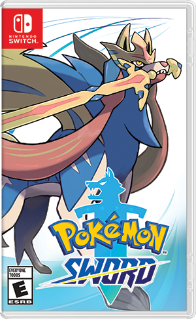
Last year was the first time a Pokémon game didn’t appear on my top ten list since 2012. I decided to skip over Let’s Go, Pikachu! and Eevee!, partly because I didn’t much fancy yet another go around the Kanto region, and partly because I was starting to feel burned out on the franchise as a whole. The seventh generation was a bit of a bust for me. 2016’s Sun and Moon felt rushed and left me feeling disappointed. Ultra Sun and Ultra Moon, released the following year, felt like the games that Sun and Moon should have been from the outset, but due to poor marketing that led me to mistake them for direct sequels in the style of Black 2 and White 2, also failed to impress me. The fact that most of my Pokémon-playing buddies seemed to fall off the series around the release of Sun and Moon probably didn’t help, either. With a year off from their annual release cycle and the jump to much more powerful hardware in the form of the Nintendo Switch, I had hoped for Pokémon Sword and Shield to be a significant evolution for the series in terms of its gameplay and presentation.
Instead, Game Freak and The Pokémon Company seem to have invested the additional time and resources into a game that has polarised their hitherto loyal fanbase. Pokémon Sword and Shield are not the leap forward that many people expected. In many respects, they can be considered a step backwards, most notably in the decision to drop support for the full National Pokédex, supposedly in favour of focusing on improving things like animations. That might have been acceptable were there actually any evidence of these promised improvements, but the games continue to use the same Pokémon models and handful of canned animations that originated in the series’ first full-3D entries, 2013’s Pokémon X and Y. Much like Sun and Moon before them, Sword and Shield feel like products rushed to meet a holiday deadline, and we probably won’t see the full potential of this generation until their ‘Ultra’-equivalent versions (likely with a reinstated National ‘Dex) see the light of day next year.
This probably reads as overly negative for a game that made enough of an impression to reach my top ten list, and sure, there are a lot of things I like about these eighth-generation games in spite of their myriad issues. The core battle mechanics remain as enjoyable as ever. I like pretty much every new Pokémon design I’ve come across in my journey through the Galar region. And speaking of Galar, boy does it feel great to finally have a pair of Pokémon games set in an approximation of the United Kingdom. The Wild Area is by far the games’ best new feature, and is hopefully a sign of the direction the series is heading in. I also thought the writing, while nothing outstanding, was pretty darn good for a Pokémon game, with some unexpected commentary on the current socio-political landscape and the climate crisis towards the end, as well as a lot of the supporting cast getting meaningful narrative arcs of their own.
I can see myself spending a lot more time with Pokémon Sword in 2020 as I endeavour to complete my Pokédex and see everything the Galar region has to offer. I may even look into doing some competitive battling for the first time since sixth-gen, or at the very least getting online for some Max Raid battles with other trainers in the near future. But unless Game Freak and The Pokémon Company can find some way of revitalising the series’ formula and actually put some major effort into meaningfully evolving the franchise going forward, Pokémon Sword is also likely to be the last Pokémon game I play for a while.
Red Dead Redemption II
(Rockstar Games - PlayStation 4 - 2018)
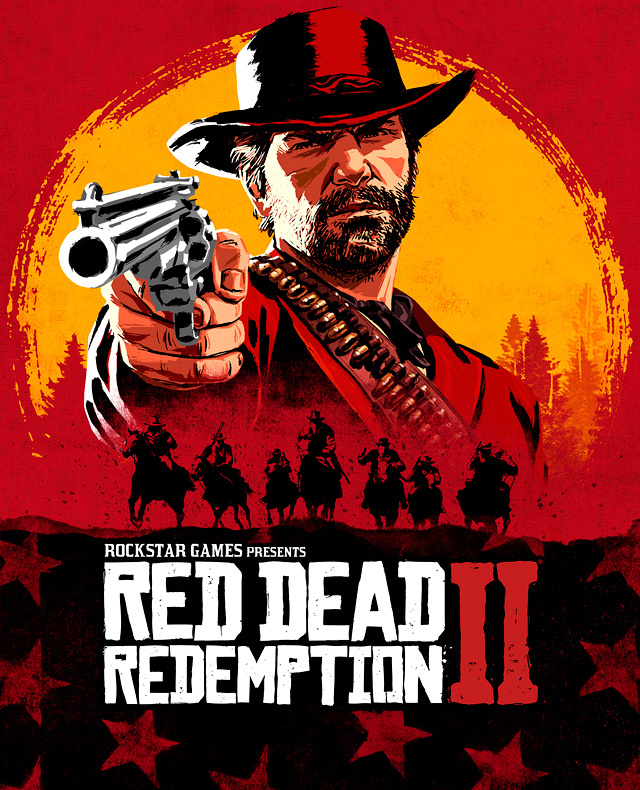
When I wrote My End of 2018 Awards this time last year, I gave Red Dead Redemption II an honourable mention and stated that it was definitely going to feature in My End of 2019 Awards. Fast-forward twelve months and here we are, the prophecy fulfilled. I’ve had a lot of time to digest the experience of playing Red Dead Redemption II, having finished it within the first week of 2019, but even now I find myself thinking back on it on a pretty regular basis.
More often than not, the subject of these reminiscences is Arthur Morgan. Going into the game I didn’t think it would be possible for Rockstar to deliver a better protagonist than John Marston, but I was pleased to be proven wrong. Arthur is an intensely likeable character, an outlaw with a heart of gold and a tongue that’s just as quick on the draw as his revolver. From his interplay with the rest of the Van Der Linde gang in the game’s early chapters to his more touching, personal moments with John towards its end, there wasn’t an interaction Arthur took part in that I didn’t come away from liking the character more. His own personal character arc, and the redemption he earns at the end of it, would have been enough to secure Red Dead Redemption II’s place in this top ten.
But Red Dead Redemption II wasn’t simply a story I experienced, and nor was it just a video game that I played. For over two months, it was a world that I lived in. I explored every region of its vast map, from the snow-capped Grizzly Mountains in the north, through the flourishing city of Saint Denis and the surrounding bayou in the south-east, to the arid deserts of New Austin and Cholla Springs in the west. I hunted in its forests and fished in its rivers, then returned to camp to cook my kills and feast on the spoils. I ran errands in its towns, and I robbed travellers and stole stagecoaches on the dirt roads between them. I watched the sun rise over mountain ridges, rode across state lines through thunderstorms, and spent nights just gazing up at the clear, starry sky. I don’t think I’ve been so utterly absorbed in a video game world since the first time I played Skyrim almost eight years ago. That is probably the best way I can convey the significance of the impact Red Dead Redemption II had on me.
Super Smash Bros. Ultimate
(Bandai Namco/Sora Ltd. - Nintendo Switch - 2018)
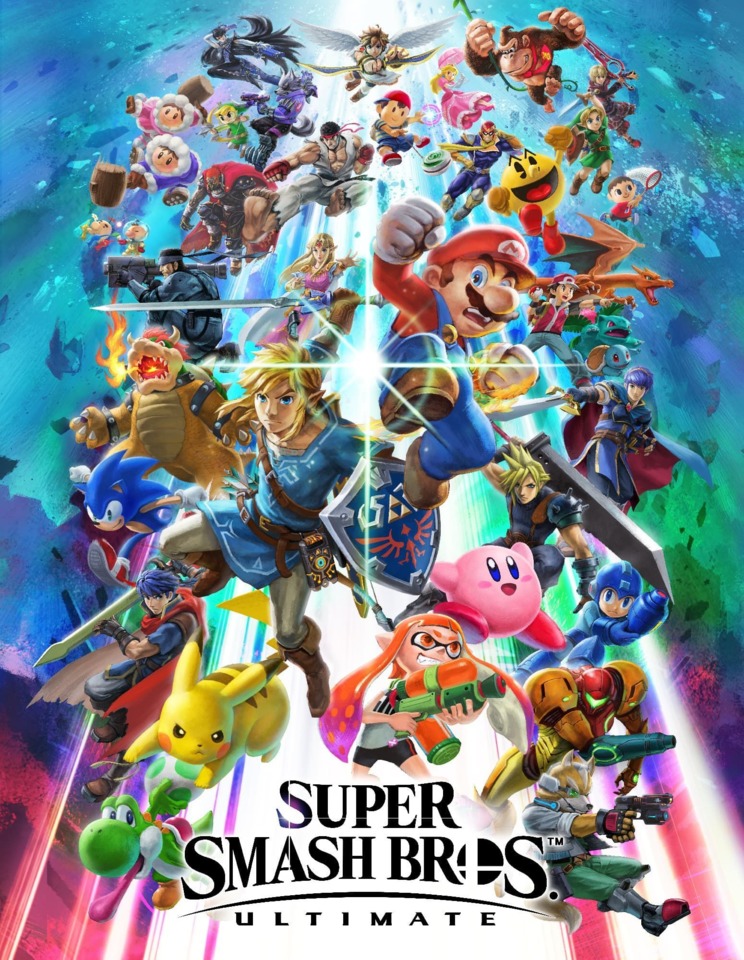
The Smash Bros. games have been mainstays of my friends’ get-togethers for years now, from Melee on the GameCube through Brawl on the Wii and the slightly less imaginatively-titled 3DS and Wii U instalments. I’ve long enjoyed the social aspect of Smash Bros., but the series’ most recent entry, the Nintendo Switch’s Super Smash Bros. Ultimate, marks the first time I’ve spent a significant amount of time with the franchise as a solo player. Initially purchased as an attempt to justify my owning a Switch for something other than Breath of the Wild and Super Mario Odyssey, I wasn’t expecting to go quite as deep down the rabbit-hole as I did this year.
The reason for that descent into the Wonderland of Smash Ultimate? World of Light. For the first time, a Smash Bros. game has offered a lengthy single-player component that actually held my interest. Set against a backdrop of the world being ravaged by Galeem, a being composed entirely of light, the player is free to navigate an overworld populated by the captured Spirits of Nintendo characters. Each of these Spirits is locked behind a themed Smash battle that borrows motifs from the character in question. Once unlocked, Spirits can be assigned to the player’s character to buff their stats and gain other bonuses, giving them a better chance of beating stronger Spirits and progressing across the overworld. It’s a really neat concept that is, for the most part, incredibly well realised. No two battles in the World of Light are ever quite the same, which explains why I was able to sink almost forty hours into this game mode without once getting bored.
Even with World of Light cleared, I still find myself jumping back into Smash Ultimate on occasion to unlock a few extra Spirits from the Spirit Board, a rotating catalogue of Spirits which can be fought in one-off battles and added to your collection upon victory. In this respect, Spirits replace the Trophies from previous Smash Bros. games, serving as collectibles as well as in-game stat modifiers. I’m currently sitting at just over 1,000 Spirits collected, with about 350 still to earn, plus new Spirits are being added all the time through the various game updates and expansion of the roster with DLC characters. And all of this is technically just icing on the cake, since the core multiplayer action I’ve always loved the series for is still intact and as enjoyable as ever. All of this adds up to make Super Smash Bros. Ultimate the best game in the series for me, and a sure-fire candidate for this year’s top ten list.
The Walking Dead: The Final Season
(Telltale Games/Skybound Entertainment - PlayStation 4 - 2018/19)
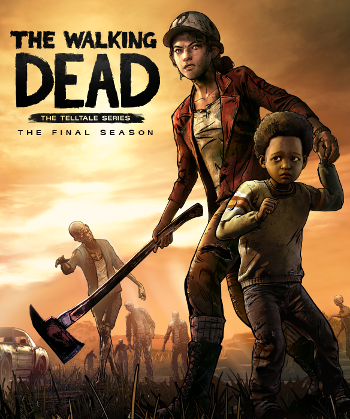
Now here’s a game I didn’t think I’d ever be writing about. When Telltale Games folded at the end of last year, I wrote off any hope of seeing a conclusion to their series based on Robert Kirkman’s zombie-filled graphic novels. Not because I didn’t want to see Clementine’s story resolved, but because her fictional fate was inconsequential next to the very real collective fates of the two-hundred-plus developers employed by the studio who had helped to bring her to life. The project’s subsequent acquisition and completion by Skybound Entertainment, under the watchful eye of Kirkman himself as well as many of the former Telltale development team, made me feel less uncomfortable about returning to see the end of a story I’ve been following since 2013.
The Final Season of The Walking Dead is, in my opinion, its strongest offering since Season One. A big part of that is probably down to how much it mirrors parts of that first season, thrusting Clementine from the role of the child into that of the parent and showing her as mentor to Alvin Junior in much the same way that Lee was to her. The moments between Clem and AJ were the highlights of this season for me, bringing the whole story full-circle in a fitting way without ever explicitly recycling anything or feeling like pandering to players’ nostalgia.
Being able to finish Clementine’s story was also personally significant for me because of the role that The Walking Dead has played in my relationship with my girlfriend Alice. In the three-and-a-half years we’ve been together we’ve played through every season, including the Michonne mini-series. Reaching the end of this season wasn’t only bittersweet because I knew I’d be leaving Clementine behind, but also because I knew it marked the end of a shared experience for me and Alice that I honestly think we’re going to struggle to find in any other video game. I’m pretty sure if Alice was writing this list, she’d put The Walking Dead: The Final Season right at the top of it. It only feels right that it earns a place on my list too.
---
So there you have it – my picks for the top ten games I played in 2019. It may not be the most exciting list, but it’s the truest one I could have written, and I’m really pleased with how it represents the time I’ve spent with video games over the last twelve months. I’ll be sure to spend the coming days getting acquainted with all of your top tens, not least to pick up some recommendations for things to play in 2020.
Speaking of 2020, this feels like the right time to mention my plans moving into next year. Many of you will be aware that I’ve taken a major step back from blogging here on Giant Bomb over the last couple of years. I’ve previously written a blog explaining my reasons for doing so at great length, so I won’t repeat myself here. To paraphrase, I don’t write much in this space any more because I feel that the audience has moved on, and it’s no longer the right space to share written thoughts about video games. I’ve spent a bit of time thinking about how I can channel my creative energy into something similar to this blog, without feeling like I’m targeting the wrong people, and I think I’m ready to share the answer I’ve come up with.
That answer is Text Boxes.

Text Boxes is a blog dedicated to written criticism and analysis of video games, focusing primarily on their stories and mechanics related to storytelling. Starting in January 2020, I will begin posting regularly on Text Boxes, sharing thoughts on the games I’ve been playing and how they choose to tell their stories and convey information to the player. I’ll also be migrating a selection of my Giant Bomb blogs over to Text Boxes in the coming months, with the intention of keeping an archive of all my best video game writing in one place.
I realise that this is not a place for advertising or self-promotion. For that reason, I won’t be attaching this blog post to the Giant Bomb forums. I also want to stress that there is no money involved in Text Boxes. There is no Patreon, no sponsorship deal, no ad revenue – it is purely a passion project, and I don’t stand to benefit financially from pursuing it. All I wish to do is invite you, the people who have enjoyed my writing enough in the past to follow me as a user of this website, to follow me once again into this new endeavour. In return I intend to show my appreciation to those who choose to read and comment on my work by being as responsive through Text Boxes as I possibly can. I realise I’ve not been great at interacting with people here on Giant Bomb in recent years, but I am determined to build a back-and-forth dialogue around these blogs by engaging in discussion with people beyond my initial posts.
Here is a link to the Text Boxes blog. If it sounds intriguing to you, please consider adding it to your list of bookmarked websites or subscribing to the RSS feed. It’s pretty empty at the moment, but I believe that over time, and with your support, it has the potential to grow into something truly special.
Thanks very much for reading folks. Wishing a happy and healthy New Year to all of you. Take care, and I’ll see you around.
Daniel
---
Currently playing - Nothing
